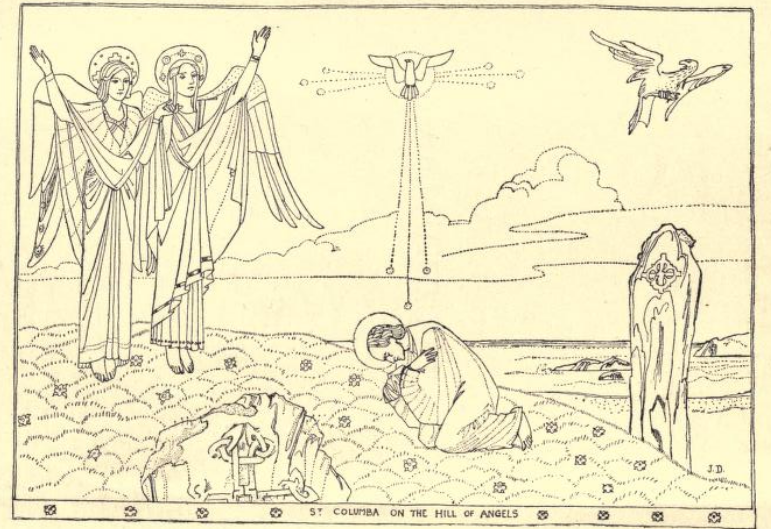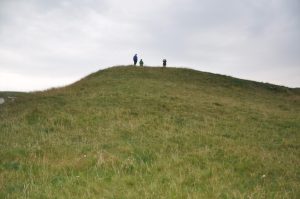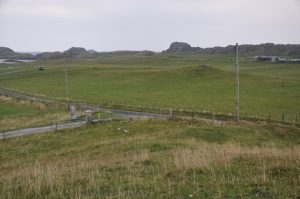The writing of this blog is prompted by two circumstances: today, the 29th of September, is Michaelmas and as we shall see in the second part of this blog post, Sìthean Mòr (Grid reference: NM270235) has traditionally had a strong association with St Michael and Michaelmas. Secondly, the Iona’s Namescape team was recently able to travel to Iona for initial fieldwork and as this was one of the sites visited, it seems appropriate to share some of the thinking resulting from that visit. This name also perfectly demonstrates one of the most fascinating aspects of Iona’s place-names: the presence of a wealth of accounts discussing one particular (relatively minor) place over many centuries, from the early medieval period until present day.
There is a Nordic expression which can be loosely translated as ‘a beloved child has many names’ (kärt barn har många namn in Swedish). This sentiment seems applicable in the context of the hill now generally referred to as Sìthean Mòr. Before delving into the various traditions associated with this place, it is necessary to unpack some of the different name forms which have been applied to it over the centuries. There are in fact two separate names to discuss here: the earliest recorded name traditionally associated with Sìthean Mòr is found in Adomnán’s Life of St Columba (c.690s) in which St Columba converses with angels on top of the hill (book II chapter 11), there referred to as Cnoc Angel ‘hill of angels’, in Latin colliculus angelorum (also see this previous blog post for more on Latin and Gaelic in Adomnán). This early account has resulted in numerous retellings of the episode, especially from the early modern period onwards with an increasing number of traveller accounts appearing in in the late 18th century (see Fig. 1 below). The name is typically given in English as Angel Hill (first recorded by Pococke in 1760) and in Gaelic as Cnoc nan Aingeal (after it was recorded by Adomnán our earliest form appears in 1771).

The earliest attested form of the name with G sìthean appears soon after in an account in 1776 by an anonymous author who gives the following description: ‘Near the midst of the island are two beautiful hills called the high and low Sion hills. Here was a grand place of worship to which they went on white horses mounted’. G sìthean ‘(fairy) knoll’ is a common element in place-names, often, as here, carrying connotations of being applied to ‘the dwelling-places of denizens of the Other World’.[1] In later forms mòr and beag are used to distinguish between the two adjacent hills (see images), but sometimes only ‘the Sìthean’ is used to refer to the larger of the two hills which has attracted most of the attention (Mairi MacArthur pers.comm.).

It is worth noting that according to standard Gaelic orthography we would expect the spelling Sìthean Mòr, but this is not how it appears on most maps, where it has variously been given as Sithean Mor, Sithean More, Sithein and Sithean, to give a few examples. This exemplifies one of the problems we face when surveying areas like Iona where we have a wealth of name-forms for relatively minor features, but where the Ordnance Survey sometimes fails to provide reliable guidance with regards to spelling. In fact, Ordnance Survey maps record a rather different form, giving the name of the hill as Cnoc an t-Sìthein (Ordnance Survey 6-inch maps). This name form is problematic; it only appears on Ordnance Survey maps and does not seem to have been current in local usage (Mairi MacArthur pers.comm.). In fact, this may be the result of a misunderstanding by the Ordnance Survey surveyor(s); if an informant described the hill as ‘the hill of (the) Sìthean’ or even ‘the hill of (the farm of) Shian’ this could have resulted in that description being interpreted as the proper name of the hill, i.e. Cnoc an t-Sìthein. Thus, as is often the case, we are faced with the problem of determining the most appropriate spelling for a name when multiple name forms exist. Should Ordnance Survey forms be followed (generally the approach used in previous Surveys of Scottish Place-names, but where the place-name material is considerably different from Iona), should names be given according to standard Gaelic orthography, or should locally attested forms be used? It is clear from this example and previous blog posts (see The trouble with Cobhain Cuildich) that following Ordnance Survey spellings can be problematic. Generally, a case-by-case approach is necessary, and both locally attested forms and standard orthography need to be carefully considered. In this instance we have opted for Sìthean Mòr as the head-form.
In addition to the two hills, the name has also been transferred to the nearby farm which is known as Shian or Sithean. This raises a rather different issue relating to naming-practices in the context of houses, farms and crofts. The authority of naming a house or farm is perhaps best viewed as falling within the remit of its occupants, but, in this instance, there are at least two different spelling

s consistently used, and they appear to run parallel. In 1851 and 1881 the farm is recorded as Shian, in 1897 as Sìthean, in 1900 and 1930 as Shian and in 1950 as Sithean. Ultimately, the names of houses and farms (also known as oikonyms, referring to all types of human settlement) reflect a constantly evolving process, arguably more so than most other name types. Therefore, where multiple names exist, both past and present forms should be taken into consideration.
For the second part of this blog, I will look more closely at some of the motifs and themes which appear in traditions associated with Sìthean Mòr. The material is presented here as a network visualisation (see Fig. 1). This is not an attempt to comprehensively explain the origins of the numerous traditions associated with the hill, but rather to note some patterns in the often-overlapping themes visible in the material.
Fig. 1 Network visualisation showing groupings in traditions associated with Sìthean Mòr. Click on individual nodes for more information about each grouping. References to all sources are listed at the end of the blog. Created using Flourish Studio.
At least three distinctive narrative strands can be picked out from this visualisation, clustered into two groups. The motif of St Columba conversing with angels, first recorded by Adomnán, is visible in several groupings, including ‘St Columba’ and ‘Angels’. This will be covered in greater detail in our next blog, but suffice it to say that place-lore of such an early date (and especially when including angels!) is noteworthy in itself and would likely have contributed to the continued engagement with the site.
Secondly, many early modern accounts describe the various Michaelmas celebrations which took place here. Our earliest record of this is provided by Pococke who writes:
I went to the South west part of the Island and in half a mile passed by a fine small green hill, called Angel Hill, where they bring their Horses on the day of St. Michael and All Angels, and run races round it; it is probable this custom took its rise from bringing the Cattle at that season to be blessed, as they do now at Rome on a certain day of the year.
Undoubtedly, his account had a major influence on reports by subsequent authors, including Pennant who directly cites Pococke in his account (‘Bishop Pocock informed me’). It is difficult to know the exact nature of the celebrations described and to what extent they were still practiced when these texts were written. As Domhnall Uilleam Stiùbhart has highlighted, Michaelmas celebrations, despite having been widely celebrated across the Hebrides, would have varied considerably depending on the island. Also, it is not always entirely clear to what extent these practices were falling out of use in many areas by the time the bulk of our written accounts were composed.[2] Certain features are consistently recorded in our sources, including the presence of horses and racing (see Fig. 1) which would likely have played an important role in the celebrations. However, we also need to remember that many authors would have relied on existing accounts, as noted above, and they do not necessarily reflect first-hand observations.
Finally, there is a multitude of traditions which are directly connected to the name Sìthean Mòr. These traditions survive in both oral and written accounts, typically relating how people (young men, hunchbacks, fishermen) venture inside the (fairy) hill, with varying results. One such story is recorded as follows:
Two young men in Iona were coming in the evening 1 fishing on the rocks. On their way, when passing, they found the shï-en of that island open, and entered. One of them joined the dancers, without waiting to lay down the string of fish he had in his hand. The other stuck a fish-hook in the door, and when he wished made his escape. He came back for his companion that day twelvemonths, and found him still dancing with the string of fish in his hand. On taking him to the open air the fish dropped from the string, rotten.[3]
Some of these stories can be firmly anchored within the wider tradition of Scottish folklore. For instance, the hunchback story (see Fig. 1) is a well-attested migratory legend.[4]
Later sources build on these existing narratives, sometimes adding new elements such as ghosts. One account describes sightings of ghostly monks at the hill: ‘Many are the reports of ghostly monks seen here over the years, often at certain spots where the local people will not venture at night-time, such as the Angels’ Hill, almost in the centre of the island, where many odd things have happened’.[5]
Having outlined some of the traditions associated with Sìthean Mòr, there is an obvious question to address: why has this particular hill attracted so much attention over the centuries? There are a couple of different lines of investigation to explore here. As mentioned above, Adomnán’s account of the hill, and the resulting early association with celestial beings would undoubtedly have contributed to its noteworthiness, both by locals and visitors to the island, especially by the time the Vita became widely accessible. Similarly, the element sìthean would likely also have prompted several of the stories featuring fairies and other supernatural elements (a search for ‘sìthean’ on Tobar an Dualchais/Kist o Riches will yield numerous stories with parallels to those outlined here).
In addition to this, I wonder if the location and physical characteristics of the hill itself may be important. It is centrally located on the island, the most prominent feature (elevation 22.7m) in a relatively flat-lying stretch of land. Several accounts reflect the mental mapping of the island as being divided into quite distinct areas, partially emphasised by the physical landscape (including West End and East End, north and south), and Sìthean Mòr falls somewhere in the middle of these zones. This may be especially relevant when considering its appropriateness as a site for Michaelmas celebrations; this would have been a significant communal event which included the whole island, and a central location for the celebrations is not surprising.
Descriptions by certain authors, including Pennant and Pococke in the late 18th century would undoubtedly have had a major influence on subsequent writers who often perpetuated very similar narratives. For example, Pococke mentions the presence of a cairn on the hill, a statement directly referenced by Pennant, and repeated by numerous later writers. By the time of detailed archaeological recording on the island, however, there is no sign of a cairn or stone circle ever having been located here (stay tuned for the follow up blog on Sìthean Mòr which will discuss this further). This example reflects a wider pattern of traditions associated with various places on Iona – the vast amount of literature written about the island has caused certain narratives to be perpetuated – and we need to carefully consider the extent to which some of these accounts are mainly the result of antiquarian speculation. Nevertheless, the wealth of place-lore associated with Sìthean Mòr demonstrates an important point relating to place-names: their transmission is rarely static and often represents centuries of changing perceptions, both by locals and visitors. The place has become a palimpsest; the result of continuously re-written and overwritten stories which have all contributed to the present artefact.[6]
[1] Taylor, S. with G. Márkus (2012), The place-names of Fife, vol 5 (Donington: Shaun Tyas), p. 499.
[2] Stiùbhart, D. U. 2012. ‘Leisure and Recreation in an Age of Clearance: The Case of the Hebridean Michaelmas’, in J. Borsje, & S. Mac Mathuna (eds.), Celtic Cosmology: Perspectives from Ireland and Scotland (Papers in Mediaeval Studies) (Pontifical Institute of Mediaeval Studies), esp. pp. 281-305.
[3] Campbell, J. G. 1900. Superstitions of the Highlands and Islands of Scotland (Glasgow: J. Maclehose & Sons), pp. 62-3.
[4] MacDonald, D. 1994/5. ‘Migratory legends of the supernatural in Scotland: a general survey’, Béaloideas 62/63, p. 75; the term can be explained as ‘A legend which is found repeatedly at different places’ (Oxford Reference).
[5] Underwood, P. 1973. A gazetteer of Scottish and Irish ghosts (London, Souvenir Press), p. 121.
[6] For further discussion on similar approaches to the study of place-names, see The Journal of Scottish Name Studies volume 14 (2020), especially the introduction by Sarah Künzler.
References to sources in Fig. 1:
Anonymous. 1771. ‘An Account of the island of Icolumbkill, taken in April 1771’, The Weekly Magazine, and Edinburgh Amusement 24 (April-June 1774), pp. 73-5, pp. 97-100, pp. 133-5.
Part 1, Part 2, Part 3.
Argyll Ordnance Survey Name Books (1868-1878), OS1/2/37/18, ScotlandsPlaces.
Donaldson, M. E. M. 1923. Wanderings in the Western Highlands and Islands (Paisley: A. Gardner), p. 386.
Gordon, S. P. 1920. The Land of the Hills and Glens (London, New York [etc.]: Cassell and Co., Ltd.), pp.144-5.
Lindsay, W.A. 1850. Iona (London: Religious Tract Society), p. 170.
MacArthur, E. 1988. ‘Summary recalled by Ena MacArthur from her father Dugald MacGormick’, quoted in MacArthur, E. M. 1989. ‘The Island of Iona: aspects of its social and economic history from 1750 to 1914 vol. 2’ (Unpublished PhD Thesis: University of Edinburgh), p. 115.
MacKay, A. 1977/6. quoted in MacArthur, E. M. 1989. ‘The Island of Iona: aspects of its social and economic history from 1750 to 1914 vol. 2’ (Unpublished PhD Thesis: University of Edinburgh), p. 115.
MacLean, H. 1887. ‘Notes on place-names of Iona’, Scottish Geographical Magazine, 3:1, pp. 35-8.
Macleod, F. 1912. Iona (London: William Heinemann), pp. 104-12.
Macmillan, A. 1898. Iona: Its history and antiquities, etc. (London: Houlston), p. 90.
Pococke, R. 1760. ‘Letter XVI, Isle of Lismore, June 10th, 1760’, Tours in Scotland 1747, 1750, 1760 vol. 1, pp. 78-89.
Sharpe, R. (ed.) 1995. Life of St Columba / Adomnán of Iona; translated by Richard Sharpe (London: Penguin Books).
Underwood, P. 1973. A gazetteer of Scottish and Irish ghosts (London, Souvenir Press), p. 121.
